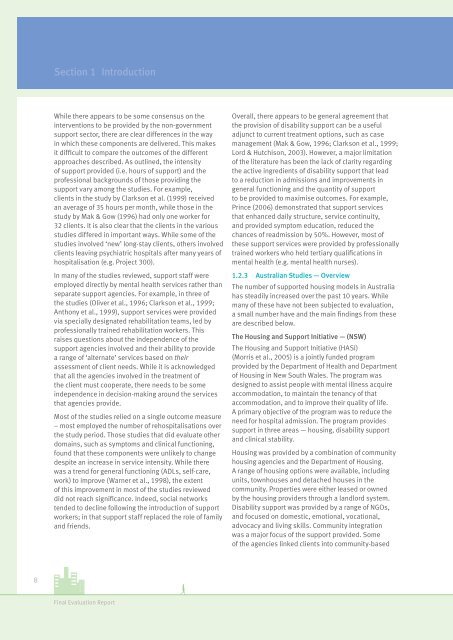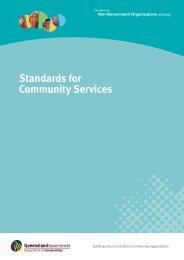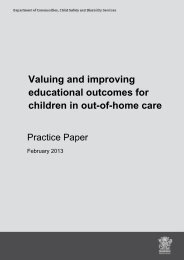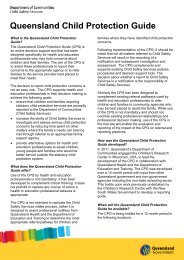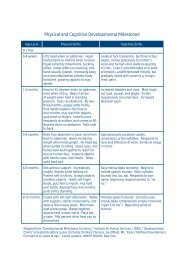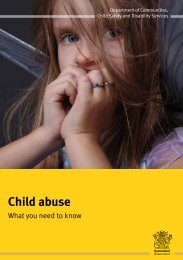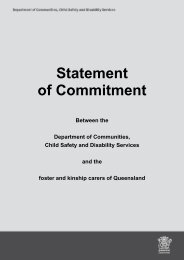Housing and Support Program (HASP): Final Evaluation Report
Housing and Support Program (HASP): Final Evaluation Report
Housing and Support Program (HASP): Final Evaluation Report
Create successful ePaper yourself
Turn your PDF publications into a flip-book with our unique Google optimized e-Paper software.
8<br />
Section 1 Introduction<br />
While there appears to be some consensus on the<br />
interventions to be provided by the non-government<br />
support sector, there are clear differences in the way<br />
in which these components are delivered. This makes<br />
it diffi cult to compare the outcomes of the different<br />
approaches described. As outlined, the intensity<br />
of support provided (i.e. hours of support) <strong>and</strong> the<br />
professional backgrounds of those providing the<br />
support vary among the studies. For example,<br />
clients in the study by Clarkson et al. (1999) received<br />
an average of 35 hours per month, while those in the<br />
study by Mak & Gow (1996) had only one worker for<br />
32 clients. It is also clear that the clients in the various<br />
studies differed in important ways. While some of the<br />
studies involved ‘new’ long-stay clients, others involved<br />
clients leaving psychiatric hospitals after many years of<br />
hospitalisation (e.g. Project 300).<br />
In many of the studies reviewed, support staff were<br />
employed directly by mental health services rather than<br />
separate support agencies. For example, in three of<br />
the studies (Oliver et al., 1996; Clarkson et al., 1999;<br />
Anthony et al., 1999), support services were provided<br />
via specially designated rehabilitation teams, led by<br />
professionally trained rehabilitation workers. This<br />
raises questions about the independence of the<br />
support agencies involved <strong>and</strong> their ability to provide<br />
a range of ‘alternate’ services based on their<br />
assessment of client needs. While it is acknowledged<br />
that all the agencies involved in the treatment of<br />
the client must cooperate, there needs to be some<br />
independence in decision-making around the services<br />
that agencies provide.<br />
Most of the studies relied on a single outcome measure<br />
– most employed the number of rehospitalisations over<br />
the study period. Those studies that did evaluate other<br />
domains, such as symptoms <strong>and</strong> clinical functioning,<br />
found that these components were unlikely to change<br />
despite an increase in service intensity. While there<br />
was a trend for general functioning (ADLs, self-care,<br />
work) to improve (Warner et al., 1998), the extent<br />
of this improvement in most of the studies reviewed<br />
did not reach signifi cance. Indeed, social networks<br />
tended to decline following the introduction of support<br />
workers; in that support staff replaced the role of family<br />
<strong>and</strong> friends.<br />
<strong>Final</strong> <strong>Evaluation</strong> <strong>Report</strong><br />
Overall, there appears to be general agreement that<br />
the provision of disability support can be a useful<br />
adjunct to current treatment options, such as case<br />
management (Mak & Gow, 1996; Clarkson et al., 1999;<br />
Lord & Hutchison, 2003). However, a major limitation<br />
of the literature has been the lack of clarity regarding<br />
the active ingredients of disability support that lead<br />
to a reduction in admissions <strong>and</strong> improvements in<br />
general functioning <strong>and</strong> the quantity of support<br />
to be provided to maximise outcomes. For example,<br />
Prince (2006) demonstrated that support services<br />
that enhanced daily structure, service continuity,<br />
<strong>and</strong> provided symptom education, reduced the<br />
chances of readmission by 50%. However, most of<br />
these support services were provided by professionally<br />
trained workers who held tertiary qualifi cations in<br />
mental health (e.g. mental health nurses).<br />
1.2.3 Australian Studies — Overview<br />
The number of supported housing models in Australia<br />
has steadily increased over the past 10 years. While<br />
many of these have not been subjected to evaluation,<br />
a small number have <strong>and</strong> the main fi ndings from these<br />
are described below.<br />
The <strong>Housing</strong> <strong>and</strong> <strong>Support</strong> Initiative — (NSW)<br />
The <strong>Housing</strong> <strong>and</strong> <strong>Support</strong> Initiative (HASI)<br />
(Morris et al., 2005) is a jointly funded program<br />
provided by the Department of Health <strong>and</strong> Department<br />
of <strong>Housing</strong> in New South Wales. The program was<br />
designed to assist people with mental illness acquire<br />
accommodation, to maintain the tenancy of that<br />
accommodation, <strong>and</strong> to improve their quality of life.<br />
A primary objective of the program was to reduce the<br />
need for hospital admission. The program provides<br />
support in three areas — housing, disability support<br />
<strong>and</strong> clinical stability.<br />
<strong>Housing</strong> was provided by a combination of community<br />
housing agencies <strong>and</strong> the Department of <strong>Housing</strong>.<br />
A range of housing options were available, including<br />
units, townhouses <strong>and</strong> detached houses in the<br />
community. Properties were either leased or owned<br />
by the housing providers through a l<strong>and</strong>lord system.<br />
Disability support was provided by a range of NGOs,<br />
<strong>and</strong> focused on domestic, emotional, vocational,<br />
advocacy <strong>and</strong> living skills. Community integration<br />
was a major focus of the support provided. Some<br />
of the agencies linked clients into community-based


